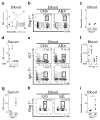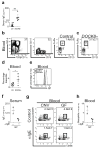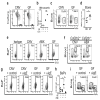Commensal bacteria-derived signals regulate basophil hematopoiesis and allergic inflammation
- PMID: 22447074
- PMCID: PMC3321082
- DOI: 10.1038/nm.2657
Commensal bacteria-derived signals regulate basophil hematopoiesis and allergic inflammation
Abstract
Commensal bacteria that colonize mammalian barrier surfaces are reported to influence T helper type 2 (T(H)2) cytokine-dependent inflammation and susceptibility to allergic disease, although the mechanisms that underlie these observations are poorly understood. In this report, we find that deliberate alteration of commensal bacterial populations via oral antibiotic treatment resulted in elevated serum IgE concentrations, increased steady-state circulating basophil populations and exaggerated basophil-mediated T(H)2 cell responses and allergic inflammation. Elevated serum IgE levels correlated with increased circulating basophil populations in mice and subjects with hyperimmunoglobulinemia E syndrome. Furthermore, B cell-intrinsic expression of myeloid differentiation factor 88 (MyD88) was required to limit serum IgE concentrations and circulating basophil populations in mice. Commensal-derived signals were found to influence basophil development by limiting proliferation of bone marrow-resident precursor populations. Collectively, these results identify a previously unrecognized pathway through which commensal-derived signals influence basophil hematopoiesis and susceptibility to T(H)2 cytokine-dependent inflammation and allergic disease.
Figures






Comment in
-
Breathe easy: microbes protect from allergies.Nat Med. 2012 Apr 5;18(4):492-4. doi: 10.1038/nm.2723. Nat Med. 2012. PMID: 22481405 Free PMC article.
References
-
- Eder W, Ege MJ, von Mutius E. The asthma epidemic. N Engl J Med. 2006;355:2226–2235. - PubMed
-
- Mowen KA, Glimcher LH. Signaling pathways in Th2 development. Immunol Rev. 2004;202:203–222. - PubMed
-
- Holgate ST. Pathogenesis of asthma. Clin Exp Allergy. 2008;38:872–897. - PubMed
-
- Vercelli D. Discovering susceptibility genes for asthma and allergy. Nat Rev Immunol. 2008;8:169–182. - PubMed
Publication types
MeSH terms
Substances
Grants and funding
- R01 AI074878/AI/NIAID NIH HHS/United States
- T32-AI060516/AI/NIAID NIH HHS/United States
- HL107589/HL/NHLBI NIH HHS/United States
- UH2 DK083981/DK/NIDDK NIH HHS/United States
- R01 AI095466/AI/NIAID NIH HHS/United States
- P30 DK050306/DK/NIDDK NIH HHS/United States
- AI074878/AI/NIAID NIH HHS/United States
- R37 AI067946/AI/NIAID NIH HHS/United States
- AI083480/AI/NIAID NIH HHS/United States
- R01 HL111501/HL/NHLBI NIH HHS/United States
- R01 HL107589/HL/NHLBI NIH HHS/United States
- R21 AI083480/AI/NIAID NIH HHS/United States
- HL111501/HL/NHLBI NIH HHS/United States
- U01 AI095608/AI/NIAID NIH HHS/United States
- R01 AI061570/AI/NIAID NIH HHS/United States
- F32-AI085828/AI/NIAID NIH HHS/United States
- AI061570/AI/NIAID NIH HHS/United States
- AI067946/AI/NIAID NIH HHS/United States
- UH2DK083981/DK/NIDDK NIH HHS/United States
- DK50306/DK/NIDDK NIH HHS/United States
- R01 AI067946/AI/NIAID NIH HHS/United States
- F32 AI085828/AI/NIAID NIH HHS/United States
- R56 AI067946/AI/NIAID NIH HHS/United States
- AI087990/AI/NIAID NIH HHS/United States
- T32 AI060516/AI/NIAID NIH HHS/United States
- 2-P30 CA016520/CA/NCI NIH HHS/United States
- P30 AR057217/AR/NIAMS NIH HHS/United States
- R21 AI087990/AI/NIAID NIH HHS/United States
- T32 AR007465/AR/NIAMS NIH HHS/United States
- AI095608/AI/NIAID NIH HHS/United States
- T32-AI05528/AI/NIAID NIH HHS/United States
- AI095466/AI/NIAID NIH HHS/United States
LinkOut - more resources
Full Text Sources
Other Literature Sources
Medical
Molecular Biology Databases

